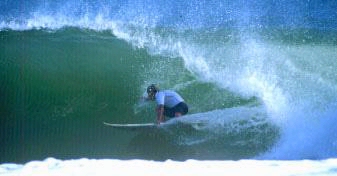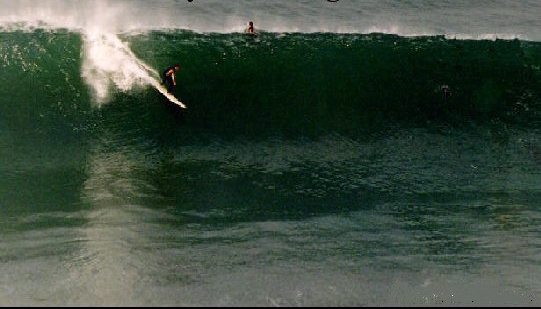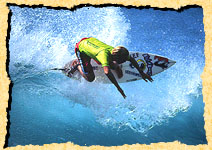

Before You Go
Learning how to stand up on a board is not an easy thing to do. In addition, simply learning to paddle out through rough breaking waves, sit on a board outside, and then paddle into a wave takes considerable balance, strength, endurance, wave knowledge, and patience. Since these techniques take time and practice to learn, and the beginner should not be expected to have success the first time out.
Usually by the second or third time out, beginners will start to acquire some balance and be able to catch and even stand up in a shorebreak wave. From this point on, the more you surf, the better you get. This section is intended to outline a basic learning approach for beginners who are somewhat athletic, but have never surfed before. Average students should be surfing on a low to intermediate level after two weeks of regular practice spending two to three hours per day. Less practice time will extend the learning time somewhat, while irregular practice will extend the learning time a great deal.
Before going to the beach, a few practice sessions on a skateboard can greatly increase your learning speed. Turning a skateboard with long, smooth maneuvers on a slightly inclined hill is very similar to turning a surfboard for the first time. The longer and flatter the skateboard, the closer to a surfboard it feels. Find a gently sloping paved hill and practice making turns by using your body as a weight rather than just twisting your body and jerking your feet. Practice at banking on a steeper hill section is also good. Smooth turns are necessary for stylish surfing.
Finding a Place to Surf (see Surf Spots)
Go to your nearest surf shop and ask people where a good break to learn is, or else give the local club a buzz (Click here for a list plus phone numbers of all the Irish clubs). Be honest about your abilities, surfers are a pretty friendly lot.
Before Paddling Out
Sit and watch the surf for a while. Watch what people are doing. Where is everybody sitting, where do they paddle out. Where do the waves break? As waves get bigger they break further out, so if everyone is sitting farther out than where the waves are currently breaking, it means that there are bigger sets coming. Watch for them.
Stretch
While you're watching the break, stretch your arms and back. Limber up.
Getting in the Water
You've noted where other people head out. Wax your stick and head down to that spot. Put your leash on. (Digression: Decide whether you're going to be a regular-foot (left foot forward) or a goofy-foot. Try both while standing on shore and see what feels better.) Put your leash on your back leg. Walk your board out until the water is about waist deep and hop on. Position yourself on the board so that the nose is just barely (2-3") out of the water. Too little and you'll be going under, too much and you'll wear yourself out pushing water.

Paddling Out
Go for nice, even, alternating strokes. When you have to get through the whitewater get up some speed and then either:
Duck Diving
I have found a few things most helpful in my duck-diving:
The key is *not* to stay under for as long as possible, just to start deep and shoot up as far on the other side of the turbulence as possible. The sooner you get back up the surface and balanced on your board, the sooner you are able to start paddling again... and that's the only way you really get outside anyway.
In the early days before leashes, it was a common practice to bail off the board just before the lip broke if you couldn't make a larger wave. The board was heavy enough that you could push the board hard and its momentum would carry it over the wave's crest. The surfer would then swim under the wave and to his board before the next wave hit. This maneuver is not practical with leashes and light modern boards.
The Line-up
Once you get to where people are sitting around (in the water, if they're on the beach, you've been paddling the wrong way) sit back and take it easy for awhile. Watch what others are doing. A nice gesture is to say hello to the others in the water. This lets them know that you acknowledge their existance and will not run them over or drop in on them. Don't be chatty though. A simple "Hello", "Howzit", "G'Day" or li'dat is fine.

Catching a Wave
This is the first of many hurdles in learning to surf. The wave knowledge - knowing which wave to paddle for and which to let pass, and the timing - when to start paddling, how fast, how much to arch your back, and when to get to your feet, are things that no one can teach you. They will come with time spent surfing.One tip I will offer: when trying to stand up, stand up. Don't get to your knees first, that leads to kneeboarding (A curable illness).
1.Don't go to the most crowded/famous. Start at a mellow beach. Gentle waves. Sand bottom. Broad sand beach. You can't run before you walk.
2.Paddle out, and try to catch the whitewater in while riding on your belly. (If you've body-boarded or body-surfed before, skip to step 5) You may have to adjust how far forward/back you lay on the board. You want about an inch of room between the nose of the board and the surface of the water. You'll need to be paddling in and have the wave catch you and push you even faster in the same direction. Stay on the board as you zoom towards shore. Steps 2-4 may best be accomplished on a mat or a boogie board or something else easy to get "wave knowledge".
3.Once you can reliably pick a wave and catch it, start trying to angle this way and that under control. Try going both ways, left and right.
4.When you can zoom back and forth at will, you're ready for a bigger step. Take a wave right before/where it's breaking, and ride it while turning to keep right at where the wave is breaking. Figuring out just where to paddle to so as to catch the wave at the right spot is a major part of the game.
5.When you can catch waves reliably, you're going to want to try riding them standing up. Paddle and let the white water catch you. As soon as you're moving, jump to your feet. This is difficult. It's really worth it to practice the jumping from prone to your feet on land first and get it well-rehearsed before doing it on a moving board on the water. Foot placement is crucial. You'll want your back foot near the tail of the board and your front foot somewhere in front of that, near the middle of the board, say. Look at other surfers. Practice on a rough template of the board on the ground. Ride the wave in. Depending on the size of the board either balance on it (bigger) or move it to stay underneath you (smaller).
6.Once you can reliably get up, you want to start angling while riding the white water. Both ways, zooming back and forth under control.
7.Once you can do that, move to catching the wave right where it is breaking. This will get trickier, because you'll have a more vertical take off point and the board will have a tendency to sink the nose as you go down the face of the wave. You want to catch the wave by angling in the direction the wave is breaking.
I'm not sure 2-4 are necessary (certainly not for someone who's been in the ocean on other things, but probably are a good safety precaution.
Reading the Waves
Surfing has the appearance of looking pretty easy. You would think it is just a paddle out, turn around, and wait for the perfect wave to surf in. Appearances in this sport couldn't be farther from the truth. Just the paddle out on some days can feel like a four day affair if you don't know what your doing, and riding the face of the wave takes uncanny balance, skill, and ocean sense that is not learned in a day. The following break down will help explain the art of surfing, but a lot of practice in all types of surf conditions will be the only way to really learn this awesome sport.
There are a number of different breaks where surf happens, depending on the shape of the ocean floor or the type of obstruction that might be causing the waves to break. There are pier, reef, shore, point, and peak breaks. In our local area, Ocean Beach is a peak beach break where the waves are caused by the moving sandbars under the water. Fort Point, a sweet left break under the Golden Gate Bridge (South side) is a point break that really cranks when it goes off on a good northwest swell. Each individual wave is then broken down into the face, shoulder, lip, trough, and if your lucky, a tube. These are easily identified by looking at any wave that's breaking. Before you ever paddle out, spend some time watching the waves from shore to figure the different tendencies of that particular surf break. This studious approach will make your paddle out a lot easier by avoiding the impact zone and your overall surf session a lot better.
Paddling Out
The first important decision to make is where to begin your paddle out. Step back from the beach and figure out where the channel is. This is the deep water passage located to the left or right of the waves breaking in the shallower water. Finding this channel will make the paddle out a lot easier than trying to bang your head straight into the breaking waves. Since at some point of the paddle out you will run into waves breaking, it is very important to learn to dunk your board, or you will be pushed back to where you started from. This duck dive, as it's called, is the single most important aspect of surfing to learn right away, or you might never make it out to the breaking waves to even learn surfing.
Catching a Ride and Standing Up
Once you've picked out the swell to ride, turn in and start paddling hard. The biggest mistake new surfers make is not paddling hard enough. They stop paddling as soon as they think the wave has them, only to miss it.
Take a few more paddles even though you think you have it. Once the wave takes you, for the first couple of rides just enjoy and don't even try to stand up. The speed will be fun enough. Get to know your board and the perfect "spot" for your weight to be. If you are too far forward, you will pearl straight down into the water and fly off the board. If you're back too much, you will never catch the wave.
Once you have this catching the wave down, you are ready to stand up. The most important aspect of this is to first find out whether you are goofy footed or regular footed. The best way to find out is stand on a skateboard or put your surfboard on your bed and stand on it. If it feels more comfortable with your left foot forward you it means you are regular footed. If your most comfortable with your right foot forward you're a goofy footer. This matters later for standing up and how comfortable you are going left or right on the wave. Goofy footers will find going left a lot easier in the beginning and vice versa for regular footed surfers.
The key to getting up on a surfboard is making it one fluid motion from the paddle position to standing. As your paddling and feel the wave start to take you, put both hands on the rails, pushing down hard so the board stays in the wave, and to propel you right to a crouched standing position as the board falls away. Make sure to keep your knees bent and that butt way down to give your stance more stability. Keeping your feet well apart and knees bent will automatically put you in the right position. Your front foot should then push the board down the face of the wave. By now your arms are out in front of you for balance and correcting. Put a smile on your face because you are now a surfer.
Having Fun on the Ride
Once you get the standing up part wired the real fun of surfing starts. In the beginning of the learning curve you will stand up and ride the board straight down the wave directly towards the beach. This gets old real fast because you will out-run the wave, slow down, and the white water will then catch you and knock you over. Not cool.
The key to successful wave riding is to develop a good "bottom turn" to leverage you back on the face of the wave and keep you riding. This bottom turn is executed after the take off when you are out in front of the wave after shooting down the face. This way your board has picked up some speed. These bottom turns are tricky in the beginning and you might fall a lot. Keep practicing, remembering to keep your knees bent and your butt down for stability. On a good long ride you might execute four or five bottom turns while picking your line up and down the face of the wave.
This basic explanation is enough to get you going. From here you'll have to learn the off the lip moves, tail slides, and floaters on your own. Just make sure that you have the fundamentals down before you even try these acrobatic moves. There is no better feeling than when you feel "on" and riding a surfboard in big, glassy surf.
Wipeouts
Wipeouts are the fine art of falling off your board. You're going to have a lot of them so don't get frustrated. They can take many forms, and crashes can actually be a lot of fun. Just be careful of the board that's attached to your foot coming back to hit you. The best thing to do is when falling down, stay under the water as long as the ocean wants to keep you there. Don't try to claw you way back to the top because it only tires you out. The waters here generally don't have the scary reefs like Hawaii so there is nothing to fear in that regard. If you try to fight your way to the surface there is a good chance you will run out of breath and possibly panic. Just relax and when you do resurface, your board will be right there. Just paddle back out quickly so as not to get stuck inside when the next set of waves comes through.
Also apply a lot of wax or the newer track pads for better foot traction on your board. The better the foot traction the less wipeouts.
Rules of the Road (see Surf Rules)
When the surf is good there is usually some kind of crowd. This is true at the local breaks here and just about any break in the world. Therefore you have to know the rules to avoid accidents and dropping in on some other surfer.
You need to know that on a breaking wave, the inside surfer has the right of way. The inside person is defined as the one closest to the peak of the wave. On a right breaking wave this means anybody to your left. On a left breaking wave it means anybody to your right. If there is a surfer inside you, they have the right of way. Just back paddle and pull out of the wave, making sure you are holding on to your board.
Do not drop in on other surfers, especially at new surf break. If you do there is a good chance your fins will be broken off by some pissed off locals.
The other very important surfing etiquette rule is to always hold on to your board when out in a crowded surf spot. This is especially true on the paddle out when there could be other surfers behind you. Sometimes the oncoming waves will want to rip the board from your hands as you try to execute a duck dive so hold on tight. Runaway boards, even while on a leash, tend to hit the surfers behind you in the head. This will not make you very popular at the surf lineup.

 Back to Surf Home
Back to Surf Home